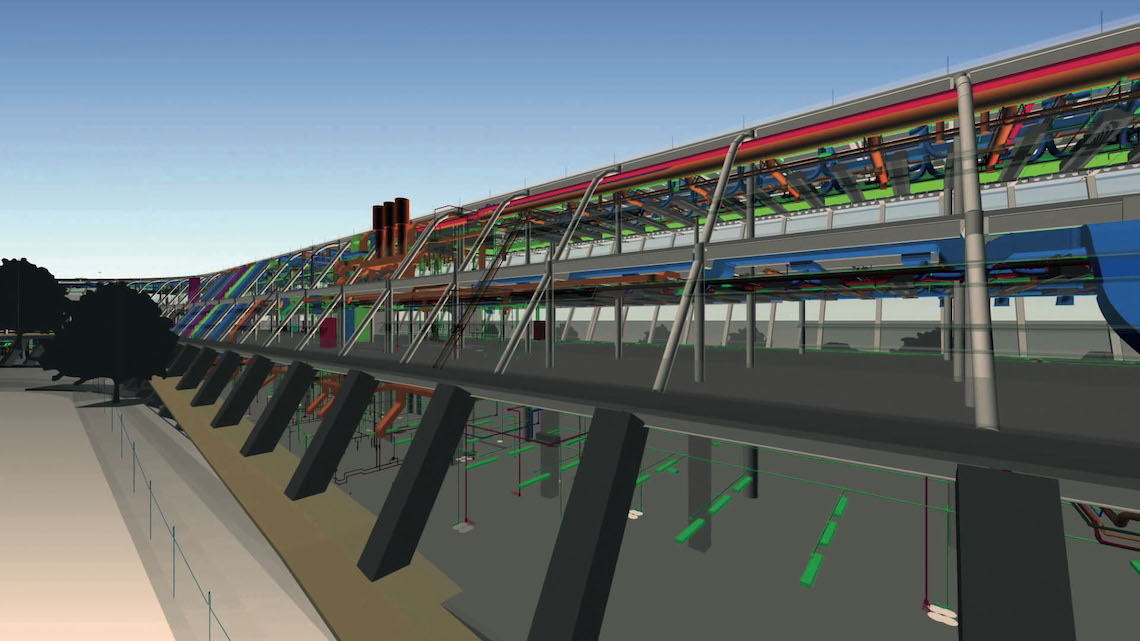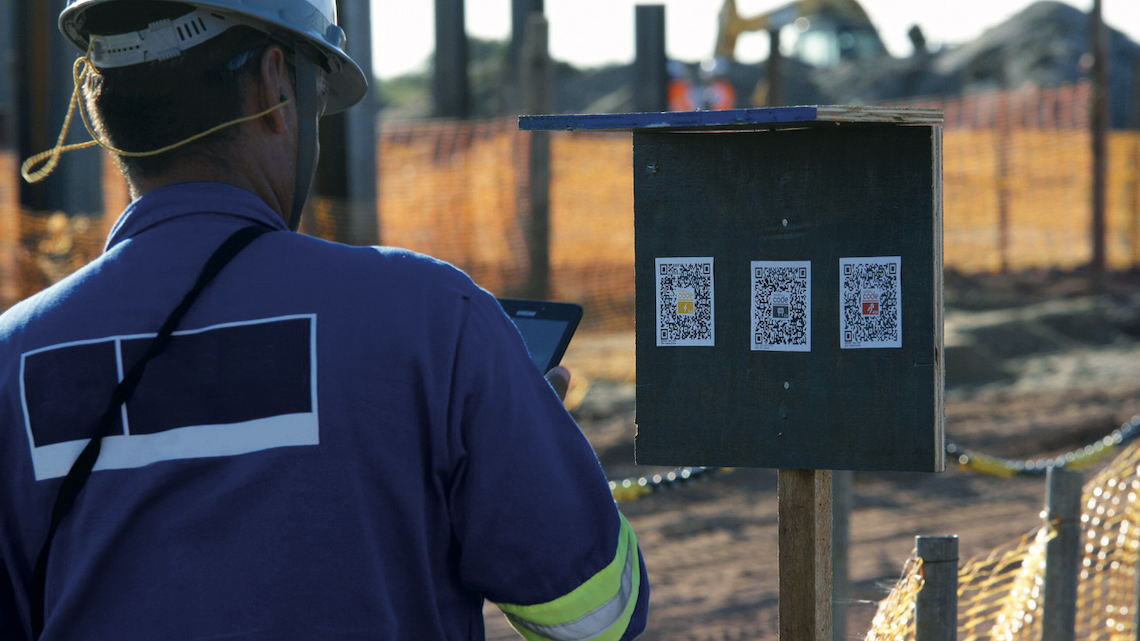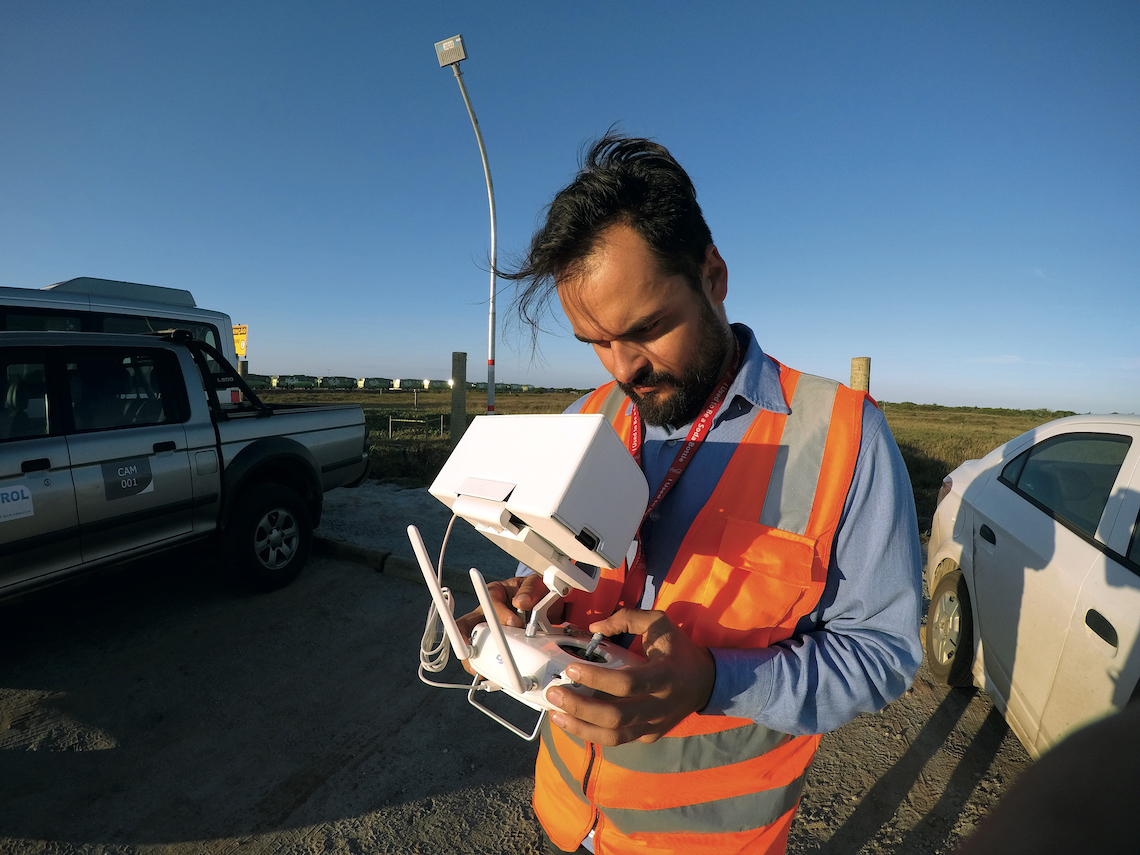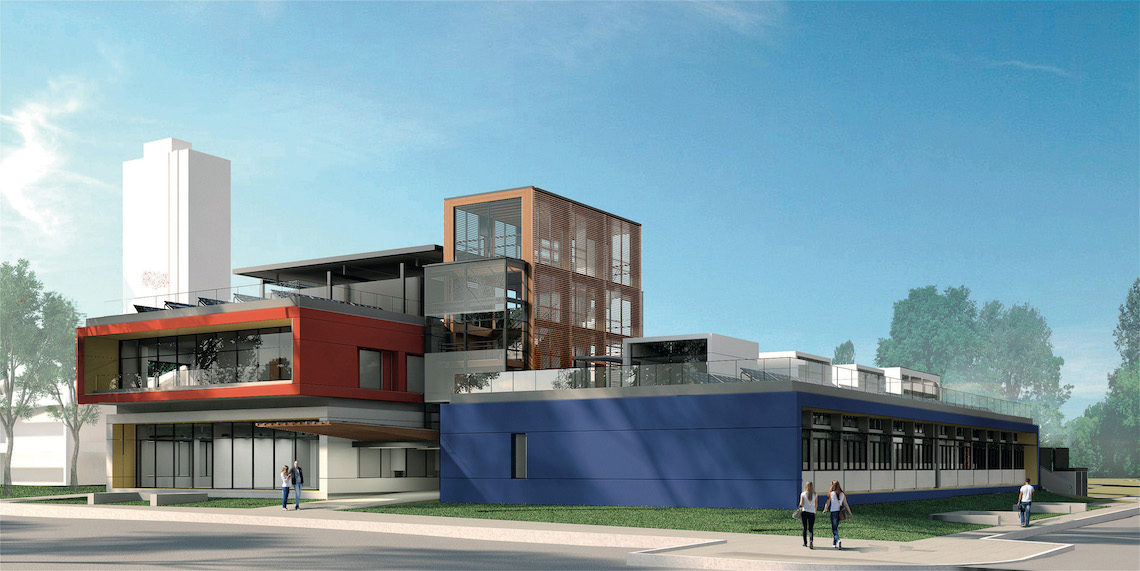The Brazilian construction industry is beginning to take advantage of digital technologies, following the trend set by many other sectors of the economy. Designs developed collaboratively in a virtual environment, mobile apps for team and project management, drones that inspect structures, and material tracking systems are all new arrivals on Brazilian construction sites. Experts estimate that the use of new technologies and mass production will modernize the sector, which has historically been marked by low productivity.
A study by US consulting firm McKinsey found that globally, construction productivity has grown by 1% per year over the last two decades, well below the growth of the industrial sector as a whole, at 3.6% per year. One reason for this is that construction is one of the least digitized sectors in the world. The study found that the use of digital technology, advanced automation, workforce training, and mass production in industrial processes have the potential to increase productivity in the sector.
One promising technology already widely used in most developed countries, but yet to gain a real foothold in Brazil, is Building Information Modeling (BIM), a digital construction process that helps organize and manage the details of every stage of a project, enabling professionals from different areas to work simultaneously and collaboratively. “The process makes construction more efficient by reducing errors and unknowns,” says electronic engineer Eduardo Toledo Santos, a professor at the Department of Civil Engineering of the University of São Paulo’s Polytechnic School (POLI-USP).
BIM involves the creation of a three-dimensional (3D) model of the building, showing the exact location of every beam, electric duct, pipe, door, and window. The system enables users to virtually simulate a design and to monitor the impact that any alteration might have on the construction as a whole. “It avoids the need to correct failures when the work is in progress, which always leads to delays and wastage,” emphasizes Toledo. As well as the 3D module, BIM offers a number of lesser-known features, such as BIM 4D, which adds the dimension of time via project scheduling and optimization of construction stages, and BIM 5D, which includes information on materials and costs, allowing users to preplan expenses and recalculate them when there are changes.
Greater use of Building Information Modeling (BIM) could increase the GDP of the construction industry
A study by the Brazilian Industrial Development Agency (ABDI) concluded that the adoption of BIM could reduce total construction costs by around 10%, as well as increasing productivity by the same figure. The agency estimates that if 50% of construction companies were to start using the process by 2028, the sector’s GDP would increase by 7%. However, a 2018 survey of 700 Brazilian construction companies by the Getulio Vargas Foundation found that only 9% use BIM.
The survey was the basis for a new initiative launched by the federal government last year: the National BIM Dissemination Strategy aims to encourage progressive adoption of the digital process, most notably in public projects. The aim is to reduce the productivity gap between the Brazilian construction industry and the USA, China, and the EU. Productivity in Brazil is four times lower than these countries, according to ABDI estimates. “Brazil is well behind in terms of adopting BIM. There is no doubt that this process leads to increased productivity,” affirms Toledo.
Mechatronics engineer Fabiano Corrêa, a professor at the POLI-USP Department of Civil Engineering, believes Brazil’s low efficiency compared to other countries is also a result of the inadequate skills of the workforce, which slows down the implementation of new digital technologies. “Businesses and the government both have an interest in this situation. Construction companies reduce immediate costs by paying lower wages, and the delay caused by low productivity is then transferred to the consumer. It is a very difficult culture to try to change,” says Corrêa.
Remote sensing
There are also digital technologies that help monitor existing structures, reducing the risk of disasters such as dam breaks, as well as traffic problems like those caused by the forced closures of several overpasses in São Paulo. GeoOndas, a company based in São Paulo, has created a system that uses the Internet of Things (IoT) to monitor the integrity of bridges, overpasses, and other structures in real time using wireless sensors capable of detecting movements, deformations, vibrations, temperatures, and the positioning of constructions.

MHA Engenharia – Project Management and Worksite Design
Detailed three-dimensional building design created using BIMMHA Engenharia – Project Management and Worksite DesignThe project, funded by FAPESP, is innovative in its use of long-range data transmission (LoRa) with a low-power wide-area network (LPWAN). Data is usually transmitted using the Wi-Fi and ZigBee standards. “Traditional networking standards consume a lot of energy and transmit data across a short range only, making it expensive and difficult to continuously monitor large areas,” explains Edgar Rodolfo Randán Sanabria, managing partner at GeoOndas.
According to Sanabria, while Wi-Fi and ZigBee cover about 100 meters (m) and 70 m respectively, LoRa can reach approximately 5 kilometers (km) in urban areas and 20 km in rural areas. The data transfer rate, however, is slower. “Structural monitoring does not require extensive data transmission. But we do still need to verify the viability of the LoRa/LPWAN system for different structure types,” he says.
Bruno Rondani, the CEO of 100 Open Startups, a platform that connects startups and large companies, says the construction industry is now waking up to the possibilities provided by the digital revolution. According to Rondani, the creation of the first construtechs (startups that specialize in construction) in 2015 was a turning point. Today, more than 200 such companies are registered on the platform.
The first wave of startups created technological solutions for support areas, such as equipment leasing apps and 3D simulations for points of sale. A second wave—the pursuit of technological applications for the construction process itself—has gained momentum more recently. “There is a growing demand from companies that has still not been fully met,” says Rondani. 100 Open Startups is currently working with university researchers with links to the sector to encourage the creation of new construtechs that focus on productive processes. “There are about 2,000 patents with potential business applications,” he says.

Andrade Gutierrez
Brazilian engineering companies already use QR-code labels at construction sitesAndrade GutierrezLarge construction companies are also backing the pursuit of new technological solutions. In 2018, Andrade Gutierrez created the Vetor AG accelerator to support innovative startups developing new technologies that reduce costs, time, and manpower. In addition to mentoring and sharing resources in a coworking space, startups in the accelerator are able to use the company’s ventures as pilot projects.
Among the startups chosen is Maply, which uses drones to map and monitor construction sites, and ConstruCode, a QR-code-based project management app for worksites. In a traditional system, project updates are printed on paper and distributed to the team. With digitization, projects use smart labels that are viewed on tablets and cell phones. André Medina, innovation manager at Andrade Gutierrez, says that this process expedites the dissemination of information and better organizes the work, preventing errors such as team members using old designs. The app also significantly reduces the use of paper, with up to 90% less printing involved.
Mass production
Another initiative promoting construtechs is the Digital Construction Network, which was created in 2018 by the EnRedes project and is run by São Paulo–based consultancy Centro de Tecnologia da Edificações (CTE). It involves 32 companies from the construction production chain, including Basf, Cyrela, Deca, MRV, and Saint-Gobain. “Our aim is to connect startups and established companies and to demonstrate the challenges and requirements of the sector to entrepreneurs capable of proposing innovative solutions,” says CTE president Roberto de Souza.

Andrade Gutierrez
Brazilian engineering companies already use drones at construction sitesAndrade GutierrezEnRedes plans to launch a Mass-Production Construction Network this year. According to Souza, more than 95% of Brazilian construction is done by masons laying bricks and mortar. “The technique requires no skilled labor and is often unplanned, low-quality, and wasteful,” he says. “Mass production makes the process more efficient and increases scale.”
POLI-USP’s Fabiano Corrêa explains that mass production in construction involves prefabricated structures that are delivered ready-made to the building site. Among the advantages of this method are standardization, greater quality control, and speed, since several project stages can be executed at the same time. Less is spent on raw materials and wastage is lower, since the structures are made to specification. The method is not often used in Brazil due to tax issues, skills shortages among the workforce, and low flexibility in construction projects.
At Tecverde, 70% of the construction process takes place in a factory. The Paraná-based company’s eco-friendly approach uses trees from planted forests to manufacture wooden panels with preinstalled windows, electrics, and plumbing. The panels are eight layers thick, providing durability, thermal and acoustic insulation, and aesthetics similar to brickwork. According to José Márcio Fernandes, the company’s managing director, the system generates 85% less waste than a conventional construction and reduces water and energy costs by 90%. “A house can be delivered in just two days, costing 10–20% less than a traditional brick property,” he says.
Tecverde has delivered more than 3,000 houses and buildings (up to four stories) using the technology, and is preparing for a new advance towards industry 4.0. Fabiano Corrêa is working in partnership with the company on a project involving two types of IoT sensors. One uses radio-frequency identification (RFID) to track items at each stage of the production chain and determine the time taken by the process. The other uses ultra-wideband (UWB) radio technology to map employee activities step by step. The project, funded by FAPESP, will help optimize work routines and logistics.

CICS Living Lab – Office Design Aflalo Gasperini Arquitetos
Virtual model of the new Construction Innovation Center at the USP Polytechnic SchoolCICS Living Lab – Office Design Aflalo Gasperini ArquitetosIn addition to low productivity, another problem the construction industry faces is environmental impact. Civil engineer Vanderley Moacyr John, coordinator of the Civil Construction Unit at the Brazilian Industrial Research and Innovation Company (EMBRAPII) and one of the Brazilian National Institutes for Science and Technology (INCTs) for Advanced Eco-efficient Cement Technologies, points out that construction accounts for 50% of all natural resources extracted globally each year and 8% of the carbon dioxide emitted worldwide. “It’s unsustainable. We need to establish new paradigms for the construction industry,” he says.
John, who is also a professor at the POLI-USP Civil Engineering Department, believes that mass production and the adoption of prefabricated wood, steel, or concrete panels instead of conventional masonry is an important step toward reducing the amount of raw material needed and the amount of waste produced. But it is not enough: the materials used need to be more eco-efficient.
One of the INCT’s priorities is the development of a type of concrete that uses less cement. Produced at a temperature of 1,500 degrees Celsius, the production of traditional cement requires a lot of energy and emits high levels of carbon dioxide. The newly proposed formulation substitutes some of the cement with a finely crushed limestone filler that requires no heat treatment. The concrete is being developed together with InterCement, a cement company from the Camargo Corrêa group. Prefabricated panels made of the material will be used to build the new headquarters of the POLI-USP Construction Innovation Center (CICS), which will provide a space for demonstrating innovative materials, production processes, and solutions that increase productivity and promote eco-efficiency in the construction industry.
Research centers around the world are studying the use of robots, wearable technology, and 3D printing in construction
The growing use of digital tools in the construction sector and the search for new solutions to increase productivity is a global phenomenon. The Swiss National Center of Competence in Research (NCCR), part of the Federal Technology Institute in Zurich, has developed a mobile robot equipped with a mechanical arm, sensors, and cameras. After generating a three-dimensional map of the construction site, the In situ Fabricator automatically positions itself and performs scheduled tasks such as building a brick wall or a steel rebar mesh for a concrete wall.
In the USA, the Design Laboratory at the Massachusetts Institute of Technology (MIT) is working on a project called Safety++, which explores the use of embedded sensors and the Internet of Things (IoT) to increase safety through wearable technologies. Some of the ideas include jackets that warn of the presence of harmful toxins in the environment and shoes that alert the wearer if they are carrying too much weight.
One technology the experts expect to see more of in the near future is additive manufacturing (3D printing) in the production of walls and structures. Many universities and corporate research centers in the USA, Germany, China, and Brazil have dedicated themselves to the same challenge. In Brazil, the INCT for Advanced Eco-efficient Cement Technologies is studying 3D-printed concrete molds for unconventional geometries. “As well as reducing waste, additive manufacturing speeds up the production process and allows the customer to choose specific characteristics such as color and shape,” says Vanderley Moacyr John, coordinator of the INCT.
Projects
1. Web platform for real-time monitoring of civil engineering structures using a wireless sensor network: Deformation, movement, rotation, temperature, positioning, and vibrations (Fiber Bragg grating) (nº 18/08715-2) Grant Mechanism Technological Innovation in Small Businesses (PIPE); Principal Investigator Carlos Leonardo Herrera Munoz (GeoOndas); Investment R$194,081.37.
2. Integrative BIM and IoT platform: Construction 4.0 (nº 17/03258-0); Grant Mechanism Regular Research Grant; Principal Investigator Fabiano Rogério Corrêa (USP); Investment R$75,888.13.
3. INCT 2014: Advanced Eco-efficient Cement Technologies (nº 14/50948-3); Grant Mechanism Thematic Project; Principal Investigator Vanderley Moacyr John (USP); Investment R$2,024,814.07.


